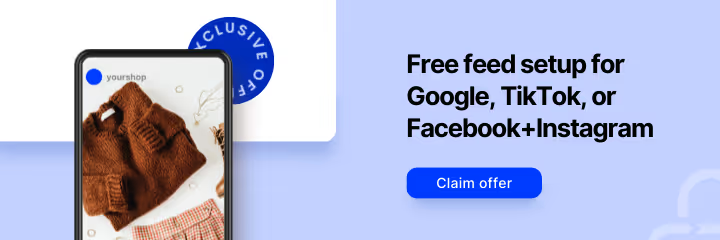Selling your products in online marketplaces can dramatically expand your ecommerce business and add exponentially to your bottom line. But the process of moving from a single selling platform -- like an online store -- can be complicated. The key to expanding your products' reach with success is to properly vet each marketplace to find the right fit.
Marketplaces offer retailers immediate access to large built-in customer bases and all the credibility and trust that comes with their stamp of approval. Each marketplace, however, has its own set of qualifiers, rules and data requirements so you'll want to get to know these before planning your next move.
To help you sort it all out, we'll go over some of the most popular online marketplaces and break down their benefits to sellers. No matter where you're selling today, expanding to more marketplaces is the most efficient way to multiply your income.
The two most common marketplace platforms for sellers to start on are Amazon and eBay but you might expect that will change soon with the emergence of Walmart's third-party marketplace. That’s because each nurtures sellers’ growth in uniquely different ways and both offer great customer support, which results in buyer trust and loyalty that trickles down to the seller.
Amazon
Amazon needs no introduction, and we will be covering it in depth next week. A huge advantage to Amazon sellers is using their FBA (Fulfillment by Amazon) service. Using FBA makes your products eligible for Amazon Prime two day free shipping.
Amazon sellers benefit from a very high volume of shoppers, which helps retailers move products faster than most other selling channels.
Amazon's reviews are its key selling point. Savvy sellers provide excellent shopping experiences and customer service to wow their shoppers and get great reviews in return. Product listings are standardized but sellers can compete based on reviews and price.
Also consider Multi-channel fulfillment (MCF), an optional feature in FBA which permits sellers to store their inventory in Amazon's warehouses and ship it to buyers who purchase from the seller's store or other marketplaces. Many eBay sellers ship their inventories to Amazon and use MCF to deliver to their eBay customers as well.
Walmart
The big news surrounding' Walmart and ecommerce last year was all about its acquisition of Jet. But online merchants are more interested in Walmart's opening of its marketplace to third-party retailers. This move will open Walmart's massive audience to online sellers, which should automatically make it a priority on sellers' 2017 to-do list. Here's why:
- Huge, loyal audience: Not only does Walmart attract millions, it’s actually the fastest-growing marketplace right now. And those customers cut across demographic lines.
- Amazing brand exposure: Lots of people shopping means lots of brand exposure. And since many of them are repeat customers, your brand has a better chance to get cemented in their memory.
- Walmart wants more products: Walmart may still be the biggest, but Amazon is catching up. Which means Walmart is fighting for customers and Because of this, there are plenty of incentives sellers can take advantage of.
- Walmart has muscle: Amazon has been able to run away from the online retail pack in part because it’s the biggest… but Walmart is bigger. Unlike other competitors, they have the resources and brand trust to really fight back.
- You’re getting in on the ground floor: In 2014, Walmart’s online marketplace had six third-party retailers. Six. That number jumped somewhere north of 300 in 2016, but it’s still quite low. Starting to sell there now means you can benefit from the minimal competition and forge relationships with customers before other merchants jump on the bandwagon.
eBay
eBay is great for retailers because it is scalable. It’s easy to sell as many or as few products as your store or brand carries; you can sell one product at a time or you can sell thousands. eBay also let’s sellers customize listings, shipping preferences, payment options and even selling formats (auction or “buy it now”).
eBay pays daily while Amazon pays out every two weeks.
Here are some pros to selling on Amazon:
- eBay pays daily
- eBay Fulfillment Service: low cost inventory charges - no long term storage fees
- Multi-channel fulfillment: eBay will ship your products you sell from your store or from other marketplaces
- No minimums; no setup fees; no long term contracts
eBay is a great marketplace to start on. Be sure to search on YouTube for more videos on how to get started and expand on both.
Jet
The moment Walmart put its weight behind Jet, this little marketplace's status changed from ecommerce disruptor to bona fide marketplace. With more than 5 million unique monthly shoppers and only 3,000 total sellers, retailers would be savvy to migrate while the numbers are still highly favorable.
Let's take a closer look at what Jet has to offer sellers:
- Sellers are only get charged a commission fee: Many other marketplaces bog you down with fees – listing fees, signup fees, monthly fees, and more. But Jet only takes a single commission once your sold items are fulfilled.
- There’s not the Walmart stigma: Though this may change with their acquisition of Jet, there are some who see Walmart – and Walmart products – as “cheap.” Because Jet’s branding makes saving “sexy,” selling there can help you avoid this stigma while introducing a different customer base to your offerings.
- Sales taxes are handled for you: While some marketplaces leave figuring out sales taxes to sellers, which can be a headache, Jet does this for you.
- Simplified selling strategy: If you’ve ever tried to figure out how to win Amazon’s Buy Box, you know that the way marketplace sales are awarded can be complicated. But not at Jet. They keep it simple: the lowest price wins.
- Customer access: When you sell on Jet, you can not only see buyers’ contact information, but are also allowed to contact them directly. This can help to bolster brand recognition and engagement and foster loyalty.
- Open API: Translation... many inventory management systems and other tools, including GoDataFeed in the near future, are compatible with Jet, making it easy to keep track of products on the site.
- Returns may be reduced: Jet still allows returns, but their rules are strict and they even reward customers for not returning items. It is possible that this may mean fewer returns for your business.
Newegg
While many think of Newegg as only for electronics, they have expanded in a way similar to Amazon. An excellent place to buy small appliances, they also handle sporting goods, automotive products, clothing, and industrial products. Here is the full list of categories from their site:
- Apparel & Accessories
- Arts & Crafts
- Auto & Hardware
- Baby
- Luggage & Bags
- Health & Beauty
- Home Living
- Home Improvement
- Jewelry & Watches
- Outdoor & Garden
- Sporting Goods
- Toys, Games & Hobbies
Currently, all Computer Hardware and Consumer Electronics are under evaluation and are approved on a case by case basis.
Newegg is favored by consumers who prefer to support small business; unlike most other marketplaces, Newegg is a privately owned small business rather than a multi-national corporation.
Demographics:
- 25 million loyal buyers
- Estimated revenues of 2.8 billion
Pros:
- Lower competition than other major marketplaces ~ currently 700 sellers
- Lower commissions
- Shipped by Newegg costs less than Fulfillment by Amazon
- EggXpert Review Program ensures product reviews are available when new products launch
- Newegg Premier - Their version of Prime offering free expedited shipping on qualifying products
Newegg is known for their continuous customer acquisition with 30% B2C customer loyalty and 70% B2B retention.
Rakuten
Leading international platform with 12 millions shoppers per month, Rakuten is one of the Top 3 shopping marketplaces. Based in Japan, these stats are from Rakuten Expo 2015: What Retailers Need to Know:
Demographics:
- 75% of users are 18-54 (according to Comscore)
- 50% married and half of those have children
- Affluent: home owners with an average $75k annual incomes
- College educated audience 27% more likely to be in management
Pros:
- Rakuten does not compete with sellers
- No listing fees
- Built in email solution
- Branded storefront
- Rakuten Super Logistics
By selling on Rakuten and shipping your inventory to them, you can reach buyers around the world without having to know how to deal with any legalities or even how to ship. See more details in What We Learned at the Rakuten Expo.
Sears Marketplace
Sears offers three different ways sellers can tap the Sears audience:
- Advertise on Sears, paying by the click to send potential buyers to your own store
- Sell on Sears; monthly fee required
- Fulfillment by Sears - send your inventory to their warehouses and let them pick, pack and ship.
Similar to Amazon, Sears has products in almost every category. Selling on Sears means competing directly against them for buyers. Find out more about selling on Sears in our previous post.
Houzz
Houzz is the No. 1 platform for home decor and remodeling products. It boasts 4 million buyers actively remodeling their homes using the 97 categories dedicated to home decor. Homeowners make up 97% of their users.
With 13,056,293 views in just over 2 years, Houzz is creating buzz for their sellers on YouTube with entertaining videos like this:
There are 6,895,878 Home Design Photos in Houzz' collection, making it the go-to place for remodeling ideas.
Houzz is not just for product sales, either. Interior Designers use it to highlight their portfolios and land new design projects. Kenneth Lewis & Associates shares comprehensive ideas on Using Houzz for Interior Design SEO and Marketing.
Wish
Wish uses wish lists, demographics, and purchase behavior to personalize the shopping experience. Photos are the primary focus on the Wish home page. When buyers click on a photo, product descriptions and pricing are displayed.
Visitors will see primarily clothing, jewelry and accessories, but there are some other items including products for children, pets and households.
Demographics:
- 300 million users
- 2 million products recommended daily
- 10 million products added to wish lists daily
Pros:
- No fees unless you sell
- Mobile: Wish claims, "Hundreds of thousands of consumers spend thirty minutes browsing products on Wish every day. Sell your products directly to consumers on their mobile devices. "
To get started selling, see Wish for merchants.
Pricefalls
Pricefalls adds a new twist to online auctions with a social aspect. It is so different that watching this short video is the easiest way to understand both buying and selling on their platform:
Pros:
- No listing fees
- Social couponing
- Dedicated storefront
- Automated everything
- Participate in Pricefalls Daily Deals
Sellers with a lot of inventory to liquidate may find Pricefalls just the marketplace they've been waiting to see. Find out more in our post Pricefalls: Meet a New Face in Marketplaces.
Ecommerce Marketplace Summary
Hopefully this post has given you some new ideas on where to expand your business next. Read Leveraging GoDataFeed to Sell on Marketplaces for more ideas. Watch for our first installment of our Marketplaces Series next week with an in-depth look at Amazon including many brand new features.
As always, if you have questions or want to get started selling on any of these marketplaces, don't hesitate to contact us.





%20).webp)